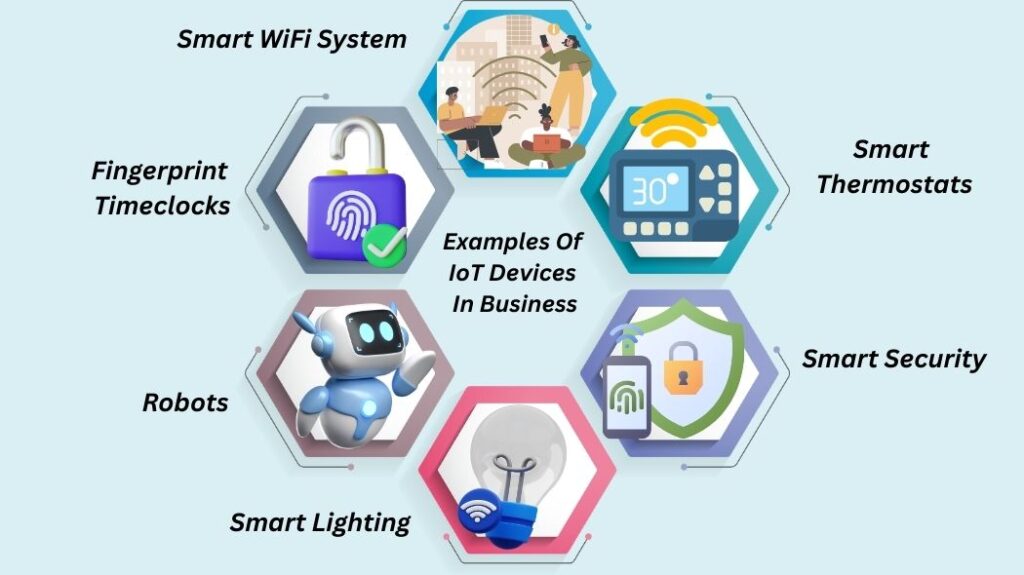Examples Of IoT Devices In Business

Smart WiFi System
Using a mesh topology, NETGEAR’s Orbi Pro WiFi 6 provides extensive WiFi coverage throughout an office space by connecting to other Orbi Pros. The Orbi Pro WiFi 6 supports WPA3 and VLAN security protocols and is designed to manage more connected devices and data than earlier Orbi Pro versions. Users can also remotely operate and monitor their network by installing the NETGEAR Insight app.
Fingerprint Timeclocks
When workers log on and off for work, WorkEasy Software’s Xenio 500 uses a sophisticated fingerprint scanner to record data in real time, even if their hands are muddy or damp. Additionally, the IoT time clock may ask workers questions, provide guidance and ideas for the workplace, and let management know when they are clocking in or out.
Read more on IoT Applications in Retail: Smarter Stores & Supply Chains
Robots
According to a GWS Robotics research, SoftBank Robotics’ Pepper has numerous sensors positioned strategically to assist it display realistic motions, including laser sensors, ultrasonic transmitters and receivers, and obstacle detectors. These Internet of Things gadgets gather information and assist Pepper in reacting like a person. Consequently, Pepper has begun to be used in environments such as senior living complexes.
Smart Lighting
To turn lights on, off, dim, brighten, and report energy usage, Lutron’s Vive Hub connects to wireless lighting sensors. The Vive Hub is easy to install, and if users wish to add more sensors, controls, or other devices, the system can grow with them. To program the IoT lighting system in your office, all you need is a smartphone.
Read more on Top IoT applications In Healthcare For Better Efficiency
Smart Security
To find suspicious or unauthorized radio signals coming from within the workspace, Bastille’s Enterprise security solution uses security sensors to collect data from company equipment. Businesses can then identify nearby security breaches, infiltrated devices, and devices not linked to their networks.
Smart Thermostats
Honeywell’s TC500A smart thermostat and its Connect Me occupant app provide remote commercial building monitoring via a mobile device. For a small business setup or one with several locations, the thermostat system can be controlled locally via an app in addition to connecting to the cloud.
Read more on IoT Applications: Revolutionizing Smart Technologies
How do IoT devices affect security?
There are various security and privacy concerns when conventionally dumb devices are connected. IoT technology has advanced faster than the safeguards in place to protect devices and their users, as is frequently the case.
The following are some of the main IoT security threats that businesses need to be aware of:
- Larger areas of assault.
- Hardware that is not secured.
- Inadequate asset administration.
- IoT shadow.
- Data transfers that are not encrypted.
- Risks to the domain name system (DNS).
- Injections of malicious nodes.
- Attacks using IoT ransomware.
- Exploits for firmware.
One of the largest remote breaches of IoT devices occurred in October 2016. Hackers broke into networks via Internet of Things devices including wireless routers and linked webcams, disrupting DNS on the east coast of the US and global services with the Mirai botnet. A cybersecurity specialist hacked a Tesla Model X in under 90 seconds without alarm in 2020 using a major Bluetooth weakness.
Protecting IoT devices and the networks they interface to is difficult because to the vast range of devices and vendors and the difficulty of installing security on devices with minimal resources. The usage of default passwords on the compromised devices was identified as the root cause of the Mirai botnet issue.
IoT security recommendations include the following:
- Identity management, authorization, and authentication.
- Cryptology.
- Encryption.
- Segmentation of a network.
- Secure passwords.
FBI Alert Number I-091015-PSA, a public service announcement, detailed IoT device hazards and offered defensive and security ideas in September 2015 to address the rapidly rising IoT attack surface.
December 2020 saw former President Donald Trump sign the IoT Cybersecurity Improvement Act of 2020. This act required the National Institute of Standards and Technology (NIST) to develop and distribute Internet of Things device handling and use standards. Despite the fact that these standards were first created for use by federal organizations, NIST created a consumer-facing IoT security device labelling pilot program in 2022. The Biden administration introduced the U.S. Cyber Trust Mark in 2023 using NIST’s standards in an effort to offer U.S. consumers items that are labelled as meeting these security standards.
An organisation should make sure they are equipped to manage the particular security problems posed by IoT devices, regardless of whether they are currently using IoT devices or are thinking about implementing them.
Top 5 Most Popular IoT Devices in 2024
Voice Controller for Google Home
One of the most widely used Internet of Things gadgets nowadays is the Google Home voice controller. Voice-activated features include volume control, lighting, thermostats, alarms, and much more.
Voice Controller for Amazon Echo Plus
Another well-liked and dependable Internet of Things gadget is the Amazon Echo Plus voice controller. Among its many voice-enabled features are call answering, alarm and timer setting, weather monitoring, and much more.
The August Doorbell Camera
With the August Doorbell Cam, an Internet of Things gadget, you can answer your door from a distance. It continuously records motion variations and questionable activities at your door.
The August Smart Lock
An established and dependable Internet of Things security gadget, the August Smart Lock enables users to control their doors from any distance. It gives your house an additional degree of security and deters burglars.
The Foobot
An Internet of Things gadget called Foobot has the ability to assess indoor pollution precisely. It contributes to better indoor public air quality in homes, cafes, offices, and other locations.
Read more on Consumer IoT Devices And IoT Devices In Industry Explained
Read more on IoT Device Management Protocols: Choosing The Right Protocol
